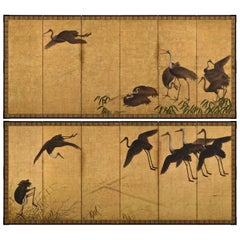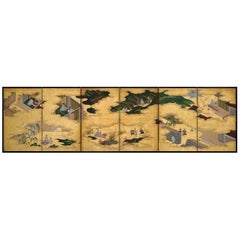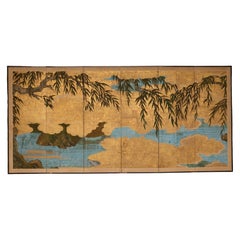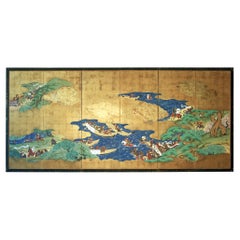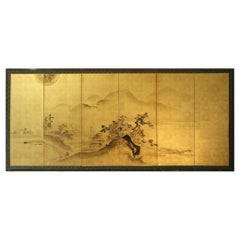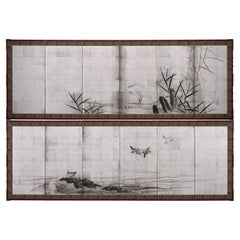Painted Paintings and Screens
to
108
342
142
673
52
6
20
9
8
6
5
4
2
1
1
1
1
1
1
75
316
282
58
102
65
36
12
1
14
2
4
10
9
7
7
2
326
277
261
169
164
639
532
331
178
59
731
698
709
17
2
2
2
1
Technique: Painted
17th Century Japanese Screen Pair. Flock of Cranes. Ink and color on gold leaf.
Located in Kyoto, JP
A pair of six-fold Japanese screens from the 17th century depicting a flock of cranes arriving at their wintering grounds. The expansive scene is heavily atmospheric. The cranes are...
Category
17th Century Japanese Edo Antique Painted Paintings and Screens
Materials
Gold Leaf
Japanese Screen Painting, Circa 1700 'Tales of Ise' by Tosa Mitsusuke
By Tosa Mitsusuke 1
Located in Kyoto, JP
A six-fold Japanese screen by Tosa Mitsusuke (1675-1710), Japan 17th-18th century, Edo period.
The signature reads Shoroku-i ge Tosa sa Konoe Shogen Mit...
Category
Late 17th Century Japanese Edo Antique Painted Paintings and Screens
Materials
Gold Leaf
Japanese antique screen - EDO period - Willow over a stream
Located in Prahran, Victoria
Antique Japanese 6 panel screen from the early Edo period (C1650). One of a pair (both available). This magnificent golden screen shows...
Category
1650s Japanese Edo Antique Painted Paintings and Screens
Materials
Gold Leaf
Edo 19th Century Japanese Folding Screen Six Panels Battle of Menpei
Located in Brescia, IT
Samurai on horseback and by boat from the famous battle of Menpei Japanese folding screen six-panel of "Tosa School" painted with mineral pigments on vegetable on golden silk , earl...
Category
Early 19th Century Japanese Edo Antique Painted Paintings and Screens
Materials
Gold Leaf
Japanese Screen Landscape on Gold Leaf with Inks
Located in Brescia, IT
Six-panel screen from the Tosa school painted with ink on gold leaf depicting a relaxing oriental landscape with pagodas, figures on boats and a beautiful sun in the sky.
The screen ...
Category
Late 19th Century Japanese Meiji Antique Painted Paintings and Screens
Materials
Gold Leaf
Japanese Silver Screen Pair, Meiji Period, Herons & Plovers, Shijo School
Located in Kyoto, JP
Heron & Plovers
Ink and silver leaf on paper
Maekawa Bunrei (1837-1917)
A pair of low six-panel Japanese screens by Maekawa Bunrei, a later master of the Kyoto based Shijo school of painting. On the right screen a solitary white heron stands motionless in a stream. On the left screen plovers play along a shoreline. The elegant forms are executed employing fluid, minimalistic ink brushstrokes. The soft brushstrokes and the sharp light of the silver leaf lend the scenes a sense of translucence. The sophisticated composition superbly exploits the long, horizontal pictorial surface of the pair of folding screens...
Category
Early 1900s Japanese Meiji Antique Painted Paintings and Screens
Materials
Silver Leaf
Japanese Ink and Watercolor 4-Panel Floor Screen
Located in Astoria, NY
Japanese Four-Panel Floor Screen, Ink and Watercolor on Paper, mounted on board, depicting mountainous landscape scene with seaside village. Panel: 55.25" H x 24.75" W; whole: 99" W....
Category
20th Century Japanese Meiji Painted Paintings and Screens
Materials
Wood, Paint, Paper
Bali Hindu Textile Framed 'Kamasan' Painting, Indonesia C. 1940
Located in Jimbaran, Bali
This captivating Balinese Kamasan textile painting showcases the distinctive style rooted in the classical Wayang tradition, unfolding a mythic tableau rich with symbolism and storyt...
Category
1950s Balinese Folk Art Vintage Painted Paintings and Screens
Materials
Cotton, Paint
Rare Japanese Floor Screen of Perched Eagles Soga Shohaku Edo period
Located in Atlanta, GA
A rare six-panel Japanese folding floor screen (Byōbu) by Soga Shōhaku (1730-1781) from Edo period. The screen depicts six perched hawk-eagles in various poses positioned in a litera...
Category
18th Century Japanese Edo Antique Painted Paintings and Screens
Materials
Brocade, Wood, Paper
Wisteria Wallpaper Hand Painted Wallpaper on Silver Metallic Panel
Located in Wuxi, 32
If you love the look of De Gournay wallpaper but not the price, this is for you. Measures: 3 ft x 8 ft.
The colorways in this sections present our latest colorways, which can be a...
Category
21st Century and Contemporary Chinese Painted Paintings and Screens
Materials
Silver Leaf
Japanese Asian Pair of Large Six-Panel Folding Byobu Screens Mythical Landscape
Located in Studio City, CA
A beautiful, alluring, wonderfully composed and engaging hand-painted large pair of six-panel Japanese/Asian Byobu folding screens depicting an almost magical/ mythical village scene...
Category
18th Century Japanese Meiji Antique Painted Paintings and Screens
Materials
Gold Leaf
17th Century Japanese Screen. View of West Lake by Unkoku Toyo.
Located in Kyoto, JP
Unkoku Toyo (1612-1668)
View of West Lake
Pair of eight-panel Japanese Screens. Ink and gold wash on paper.
Dimensions: Each screen: H. 110 cm x W. 372 cm (43” x 147”)
This pair ...
Category
Mid-17th Century Japanese Edo Antique Painted Paintings and Screens
Materials
Paper
Set of Four Japanese Silk Hanging Scrolls Screens C.1920
Located in London, GB
A stunning set of four Japanese silk mounted vertical hanging scrolls.
Dating from C.1920 Taisho Period.
The watercolour and ink on silk depicts a larg...
Category
1920s Japanese Japonisme Vintage Painted Paintings and Screens
Materials
Silk
$5,971 Sale Price / set
20% Off
Chinese Reverse Glass Painting of Taoist Immortals, c. 1900
Located in Chicago, IL
Popularized during the Qing dynasty, reverse glass painting requires an artist to essentially work backwards, starting with details and shading before adding color and form. Lending the finished work a subtle three-dimensional effect, this exacting technique doesn't allow for any corrections, and is only revealed to its full effect when the glass pane is turned around. This example dates to the late 19th century and depicts the Taoist immortals He Xiangu and Cao Guojiu. Said to have attained immortality through their studies of the natural world, the Eight Immortals each represent a different condition in life and impart blessings of prosperity and longevity. The charming scene is likely one of a set of...
Category
Early 20th Century Chinese Painted Paintings and Screens
Materials
Glass, Wood
Circa 1925. Taisho era Japanese Nihonga Screen. Camellia & Bamboo.
Located in Kyoto, JP
Anonymous
Camellia & Bamboo
Taisho era
Two-panel Japanese Screen. Mineral pigment, gofun and ink on silk.
A small Japanese Nihonga screen capturing...
Category
Early 20th Century Japanese Taisho Painted Paintings and Screens
Materials
Silk
Evolving Elegance: An Oxidized Silver Screen from the Meiji Period
Located in Fukuoka, JP
This anodized 6-panel screen captures the serene and minimalistic beauty of a bamboo grove, embodying the aesthetic principles of the Edo period. The screen features subtle and delic...
Category
18th Century Japanese Edo Antique Painted Paintings and Screens
Materials
Silver Leaf
Chinese Qing Dynasty Ancestor Imperial Officer Hanging Scroll Painting
Located in Greenwich, CT
Qing Dynasty Chinese Ancestral Imperial Officer's Portrait, 19th Century,
The imperial officer seated in dignify posture on horseshoe back chair wearing a official hat and with rank ...
Category
19th Century Chinese Qing Antique Painted Paintings and Screens
Materials
Quartz
$1,800 Sale Price
48% Off
19th Century Japanese Silk Painting by Kano Chikanobu, Phoenix & Paulownia
Located in Kyoto, JP
Birds & Flowers of the seasons
Pheasants & Plum in Snow
Unframed painting. Ink, pigment and gofun on silk
Kano Chikanobu 1819-1888
Signature...
Category
Mid-19th Century Asian Edo Antique Painted Paintings and Screens
Materials
Silk
Set of Three Robert Crowder Chinoiserie Landscape Panels
Located in Rio Vista, CA
Fantastic set of three framed chinoiserie decorated landscape panels painted by Robert Crowder (1911-2010 American). The paintings feature a flora a...
Category
20th Century American Chinoiserie Painted Paintings and Screens
Materials
Silver Leaf
Korean Painting, Wall Panel, 17th Century Ink Grapevine
Located in Kyoto, JP
Grapevine
Anonymous. Korean, 17th century.
Wall panel, ink on paper.
Upper seal:
Kou Kinun in
Lower seal:
Kaigen
Dimensions:
Measures: 98.5 cm x 29.5 cm (39” ...
Category
17th Century Korean Other Antique Painted Paintings and Screens
Materials
Wood, Paper
Japanese Painting, Hanging Scroll, 19th Century Bamboo in Moonlight
Located in Kyoto, JP
Bamboo in moonlight
Gamo Rakan (1784-1866)
Hanging scroll, ink on silk.
Dimensions:
Scroll: 201 cm x 58 cm
Image: 137 cm x 45 cm
In this early 19th century work by Gamo Rakan a light ink wash applied to the silk background silhouettes the moon and suggests the atmosphere of early evening. Even though it is a literati subject, Rakan’s bamboo is quite realistic with a strong decorative style. The painting finds its inspiration from Chinese Ming dynasty painters who often used a single-tone, jet black stroke to emphasize the calligraphic nature of bamboo.
In a different era, decorative would have been seen as somewhat unrefined. But increasingly in the Edo period, it was the hallmark of high style. The Japanese people, in particular the rising merchant class, had gradually become apathetic toward the traditional Sesshu and Kano schools of painting. Chinese professional and amateur painters living in the port of Nagasaki during the 18th century had a profound effect on Japanese painting and the freshness of their style and its decorative appeal contributed greatly to its popularity. Gamo Rakan’s teacher, Tani Buncho...
Category
Early 19th Century Japanese Edo Antique Painted Paintings and Screens
Materials
Silk
Framed Chinese Watercolor Painting 'Bird on Flower' by Zhao Shao Ang in 1987
By Zhao Shao Ang
Located in Haarlem, NL
Beautiful framed painting signed and painted by Shao Ang in 1987
Zhao Shao Ang (1905-1998) was born in Guangzhou (Canton, China) he moved back and forth...
Category
Late 20th Century Hong Kong Painted Paintings and Screens
Materials
Paper
$12,000 Sale Price
20% Off
Circa 1920. Taisho era Japanese Nihonga Screen. Dahlias & Cockscomb.
Located in Kyoto, JP
Kawabe Kasho (b.1892)
Dahlias & Cockscomb
Taisho era. Circa 1920
Two-panel Japanese Screen. Mineral pigments and ink on silk.
This exquisite two-panel Japanese folding screen, pa...
Category
Early 20th Century Japanese Taisho Painted Paintings and Screens
Materials
Silk
Japanese Painting, Framed Panel, Dahlias and Roosters, circa 1920
Located in Kyoto, JP
Tanaka Tessen (b.1890)
Dahlias and Roosters
Taisho period, circa 1920
Framed painting. Mineral pigments and ink on silk.
Dimensions (framed):
H. 159 cm x W. 97 cm x D. 2.5 cm (62.5” x 38” x 1”)
An ornate and complex composition in which the artist explores almost the entire painting surface. The coloration is bold and evocative and the tinted silk ground recreates the warm golden glow of sunset. Soft, luminous brushwork details the black feathers of the roosters, which seem to cloud and blur in counterpoint to the sharper points of the eyes and beaks. Their brilliant red combs balance the composition, echoing the rich burgundy hues of the dahlias; the flowers exquisite and lifelike. Dahlias were an exotic subject favored by painters of the Taisho era.
The painting belongs to the school of Kyoto Nihonga, exemplifying the principles of decorative elegance and consumate brush technique with which it was intimately associated. Painters of the time relied on the Shijo school method, basing the forms of the composition from life sketches. Sometimes they were then integrated with elements derived from Chinese bird and flower...
Category
1920s Japanese Taisho Vintage Painted Paintings and Screens
Materials
Wood, Silk
Large Pichhavai Painting of Krishna with Female Gopis Dancing
By Rajhastani
Located in Moreno Valley, CA
A large Pichhavai painting of Krishna with female Gopis dancing
Krishna playing flute on a bed of lotus, the composition is enclosed in a lush gree...
Category
Early 20th Century Indian Folk Art Painted Paintings and Screens
Materials
Silk
Japanese Tosa School Framed Six Panel Screen Gold Leaf
Located in Brescia, IT
Japanese six-panel screen of the famous "Tosa school" made by an anonymous artist of the mid-18th century, work painted in the classic way with colored pigments and inks on vegetable...
Category
Mid-18th Century Japanese Edo Antique Painted Paintings and Screens
Materials
Gold Leaf
Qing Dynasty Period 19th Century Ancestor Group Portrait in Custom Frame
Located in Yonkers, NY
A Chinese Qing Dynasty period painting from the 19th century of an ancestor group portrait in custom frame. Created in China during the Qing Dynasty, this vertical painting features ...
Category
19th Century Chinese Antique Painted Paintings and Screens
Materials
Canvas, Plexiglass, Wood
Antique Japanese Four Panel Byobu Screen: Mandarin Ducks by Snowy Pond in Early
Located in Sheridan, CO
Antique Japanese Four Panel Byobu Screen: Mandarin Ducks by Snowy Pond in Early Spring.
Kano School painting of a weeping willow tree with branches over a stunning indigo blue pond. ...
Category
Early 20th Century Meiji Painted Paintings and Screens
Materials
Metal, Gold Leaf
Large Antique Chinese Qing Dynasty Hand-Painted Buddhist Scroll on Silk
Located in Hamilton, Ontario
This large antique scroll is unsigned and presumed to have originated from China and date to approximately 1860 and done in the period Qing Dynasty style. The scroll is hand painted ...
Category
Mid-19th Century Chinese Qing Antique Painted Paintings and Screens
Materials
Linen, Silk
Japanese Buddhist Teaching Painting
Located in Greenwich, CT
Japanese Buddhist teaching painting, set of four paintings with 24 Buddhist stories with Japanese written characters in each story on one screen. Provenance: Purchased from Christie's South Kensington...
Category
1820s Japanese Edo Antique Painted Paintings and Screens
Materials
Paper
$2,500 Sale Price
34% Off
Floral Chinoiserie Wallpaper Hand Painted Wallpaper on Purple Silk
Located in Wuxi, 32
If you love the look of De Gournay wallpaper but not the price, this is for you. Measures: 3 ft x 8 ft.
The colorways in this sections present our latest colorways, which can be a...
Category
21st Century and Contemporary Chinese Painted Paintings and Screens
Materials
Silk
Edo Landscape Japanese Folding Screen
Located in Brescia, IT
Refined work by a painter from the first half of the 19th century, from the landscape of the "Rinpa" school by a painter from the end of the 18th century, the Rinpa school.
Six panels painted in ink on gold leaf and "gofun" on vegetable paper.
The flowers are made with the "gofun" technique, natural or pigmented white oyster powder.
Rinpa is one of the major historical schools of Japanese painting. The style was consolidated by the brothers Ogata Korin (1658–1716) and Ogata Kenzan (1663–1743).
This folding screen has a very clean design that leaves plenty of room for the beautiful golden landscape.
It comes flat and you can easily hang it with our hooks.
Lucio Morini...
Category
18th Century Japanese Edo Antique Painted Paintings and Screens
Materials
Gold Leaf
Signed Japanese Meiji Period Table Top Screen, circa 1890
Located in San Francisco, CA
Meiji period Japanese lacquered and hand painted folding table top screen.
The bas relief (heavily textured) sculptural painting of a serene quiet nature setting in an intricately ca...
Category
Late 19th Century Japanese Meiji Antique Painted Paintings and Screens
Materials
Wood, Lacquer, Paint
Tibetan Painting Thangka Green Tara Turquoise Gilt
Located in Somis, CA
An extraordinary hand painted Tibetan Thangka featuring the greatest compassion Goddess Green Tara. Her round face with large kind eyes, above closed lips, all flanked by long pendul...
Category
2010s Nepalese Tibetan Painted Paintings and Screens
Materials
Brocade, Wood, Paint, Paper
$775 Sale Price
50% Off
Chinoiser roll Hand Painted Wallpaper on Gold Metallic, Accept Custom Size
Located in Wuxi, 32
If you love the look of De Gournay wallpaper but not the price, this is for you.
The colorways in this sections present our latest colorways, which can be applied to any designs a...
Category
21st Century and Contemporary Chinese Painted Paintings and Screens
Materials
Gold Leaf
Japanese Seasons Landscape 4-Panel Byobu Screen
Located in Astoria, NY
Japanese School Four Seasons Figural Landscape Scene Four-Panel Byobu Screen, gouache on paper with gold leaf, chop seal mark lower right. Larger panels: 24" H x 12" W x 0.75" D. Pro...
Category
Late 20th Century Japanese Ming Painted Paintings and Screens
Materials
Wood, Paper
Japanese Meiji Eight Panel Screen Village Landscape with Figures
Located in Rio Vista, CA
Large 19th century Japanese Meiji period eight panel byobu screen featuring a panoramic village landscape. The serene painting depicts agricultural scenes with villagers engaged in p...
Category
19th Century Japanese Meiji Antique Painted Paintings and Screens
Materials
Gold Leaf
Antique Indian Miniature painting of a Maharaja, Jaipur c. 1800
Located in San Francisco, CA
Offered here is an antique painting of an Indian Maharaja in gouache and gold on paper c. early 19th century or 1800.
A burly Maharaja stands in profile wearing a white jama or garm...
Category
Early 19th Century Indian Antique Painted Paintings and Screens
Materials
Paper
Anglo-Indian Company School Suttee Watercolour Paintings, C. 1810
Located in Kinderhook, NY
A wonderful and singular set of two early 19th century Anglo-Indian Company School watercolour paintings, likely Murshidabad, depicting 'Sati' or 'Suttee', the historical practice in which a widow sacrifices herself by sitting atop her deceased husband's funeral pyre, and the procession to the pyre. The reverses labeled "From an album of watercolours and drawings belonging to Eliza Frederica Salmon and possibly her sister Mary Salmon, daughter of William Orton Salmon who served in India circa 1800...
Category
Early 19th Century Indian Anglo-Indian Antique Painted Paintings and Screens
Materials
Glass, Giltwood, Paint, Paper
Unique Contemporary Abstract Screen Painting inspiration from the Gutai art
Located in Fukuoka, JP
Unique Contemporary Abstract Screen Painting
A one-of-a-kind contemporary abstract painting executed on a folding screen, drawing bold inspiration from the pioneering Gutai art mov...
Category
20th Century Japanese Painted Paintings and Screens
Materials
Acrylic, Wood, Paper
Chinoiserie Panel Hand Painted Wallpaper on Silver Metallic - Accept Custom Size
Located in Wuxi, 32
If you love the look of De Gournay wallpaper but not the price, this is for you. Measures: 36" W x 96" H.
The colorways in this sections present our latest colorways, which can be...
Category
21st Century and Contemporary Chinese Painted Paintings and Screens
Materials
Silk
Chinoiserie Panel Hand Painted Wallpaper on Green silk, Accept Custom Size
Located in Wuxi, 32
If you love the look of De Gournay wallpaper but not the price, this is for you. Measures: 36" W x 72" H.
The colorways in this sections present our latest colorways, which can be...
Category
21st Century and Contemporary Chinese Painted Paintings and Screens
Materials
Silk
Japanese Painting, Hanging Scroll, Mid 19th Century, Koi and Water Plants
By Iwase Hirotaka
Located in Kyoto, JP
Iwase Hirotaka (1808-1877)
Koi and Water Plants
Hanging scroll, ink, color, gold wash and gold flecks on silk
Inscription: Hirotaka
Seal: Ille...
Category
1860s Japanese Edo Antique Painted Paintings and Screens
Materials
Silk
Korean Minhwa Jakhodo Tiger and Magpie Scroll Painting on Silk, 19th Century
Located in Studio City, CA
A wonderfully painted and detailed Korean folk art Minhwa Jakhodo (The letters “jak” means magpie; “ho” means tiger; and “do” means painting) Tiger and Magpie...
Category
19th Century Korean Folk Art Antique Painted Paintings and Screens
Materials
Silk, Wood, Paint
Late 17th Century Japanese Screen. Puppy and Kittens on Gold Leaf.
Located in Kyoto, JP
Anonymous
Late 17th century
Puppy & Kittens
A six-panel Japanese screen. Ink, color, gofun, gold-leaf and gold-fleck on paper.
A medium sized late 17th century Japanese screen fe...
Category
Late 17th Century Japanese Edo Antique Painted Paintings and Screens
Materials
Gold Leaf
Paravento giapponese a sei pannelli dipinto su foglia d'argento
Located in Brescia, IT
Paesaggio giapponese: paravento a sei pannelli dipinto a pigmenti minerali su foglia d'argento.
Elegante e moderno esempio di arte orientale senza figure uccelli o fiori.
Paravento b...
Category
Mid-20th Century Japanese Showa Painted Paintings and Screens
Materials
Silver Leaf
17th Century Korean Grapevine and Squirrel Scroll Painting, Mid Joseon Period
Located in Kyoto, JP
Anonymous. Korean, 17th century. Joseon period.
Hanging scroll. Ink on paper.
Seal: Shinso
Dimensions:
Scroll: H. 200 cm x W. 31 cm (79” x 12”)
Image: H. 122 cm x W. 29.5 cm (48” x 11.5”)
The grapevine came to China and then Korea from western Asia via the silk road trade routes. By the mid-Joseon period, it was one of the most popular subjects for Korean literati painters. Grapevines were painted as a singular subject or, less commonly, in combination with squirrels, which are associated with children due to their playful nature. Together, grapevines and squirrels embody wishes for abundant offspring and wealth.
For the Korean literati artist the twisting vines, curling tendrils and round, plump grapes provided ample opportunity for expressive "brush play”. In this painting the artist has abstracted the scene and is seemingly unconcerned with discontinuities and proportion. Vines spring up from nowhere, grapes hang in random clusters and the squirrel’s head appears as if twisted backwards. For the vines and leaves we can feel a sense of speed in the brushstrokes, imparting a dynamic feel which is at once intense and animated. This contrasts dramatically with the countless tiny strokes of ink which realistically capture the texture of the squirrel’s fur...
Category
17th Century Korean Other Antique Painted Paintings and Screens
Materials
Paper
Mountain Mural Hand Painted Wallpaper on Silk Panel, Accept Custom Size
Located in Wuxi, 32
If you love the look of De Gournay wallpaper but not the price, this is for you.
The colorways in this sections present our latest colorways, which can be applied to any designs a...
Category
21st Century and Contemporary Chinese Painted Paintings and Screens
Materials
Silk
Antique Japanese Suibokuga Egrets by Kano Tokinobu, 17th century.
Located in Point Richmond, CA
Antique Japanese Suibokuga Egrets by Kano Tokinobu, 17th century.
A sumi-e ink on paper painting illustrating two egrets in reserve with no outlines contrasting with the reeds from the marsh in the background. The painting with 3 vermillion seals of the artist in the lower left corner. Japanese dry mount paper on a wood frame with thin brocade border silver leafed surround and lacquered wood outer frame.
Condition: Lighter discoloration on the lower portion of the painting, other minor signs of age, wear, stains and repairs otherwise fine condition.
Age: Painting Edo Period, circa 1670. Mounting circa 1985.
Image: 51-1/2 in. x 20-1/2 in. (131cm x 52cm)
Frame 59-1/4 in. x 25-1/4 in. (150cm x 64cm)
Weight: 6 lbs.
Provenance:
with Honeychurch Antiques...
Category
1670s Japanese Edo Antique Painted Paintings and Screens
Materials
Paper
Japanese Painting, 17th Century, Tale of Genji, Tosa School
Located in Kyoto, JP
Illustration to an unidentified chapter of the Tale of Genji (Genji Monogatari)
Tosa School (second half of the 17th Century)
Ink, pigment, gofun and...
Category
Late 17th Century Japanese Edo Antique Painted Paintings and Screens
Materials
Gold Leaf
B31 Japanese Antiques 2panels, paper, folding Screen with flower
Located in Niiza, JP
Material: paper on wooden frame
One piece: W755×H1520mm×D15mm,
Unfolded size: W1510mm
Folded size: W755×H1520×D30mm, 5kg
Packaging (sandwiched with 5-10mm plywood): 15cm x 86cm x 16...
Category
19th Century Japanese Antique Painted Paintings and Screens
Materials
Paper
18th Century Nagasaki School Tiger Screen
Located in Fukuoka, JP
18th Century Nagasaki School Tiger Screen
Period: Edo
Size: 165 x 172 cm (65 x 67.7 inches)
SKU: PTA69
This exceptional 18th-century screen from the Edo...
Category
Early 18th Century Japanese Edo Antique Painted Paintings and Screens
Materials
Wood, Paper
Bali Hindu Textile Framed 'Kamasan' Painting, Indonesia C. 1950
Located in Jimbaran, Bali
A mid-20th century 'Kamasan' cotton textile painting from Bali, Indonesia. The hand-painted image has great detail and depicts Balinese Hindu mythology. Key features of this image ar...
Category
1950s Balinese Folk Art Vintage Painted Paintings and Screens
Materials
Cotton, Paint
B0 Japanese Antiques 6panels, Gold back, crane and pine, Araki folding screen
Located in Niiza, JP
Material: gold background paper, wooden frame
One piece: W730 x H1760 mm, unfolded size: W4420 mm, 13 kg
Folded size: W750 x H1760 x D100 mm
Estimated packaging (sandwiched with 5-10...
Category
Early 20th Century Japanese Painted Paintings and Screens
Materials
Paper
Antique Thai Buddhist Banner Painting
Located in Point Richmond, CA
Antique Thai Buddhist Banner Painting, multi-coloured tempera and gold leaf on cloth, depicting Buddha Descending From Tavatimsa Heaven. An illustration o...
Category
1850s Thai Other Antique Painted Paintings and Screens
Materials
Textile, Plexiglass
Black Lacquer Chinese Four-Panel Screen with Polychrome Floral Décor
Located in Yonkers, NY
A black lacquer four-panel Chinese screen with majestic floral painted décor and crackle finish. Captivating our attention with its majestic floral painted décor, this vintage black ...
Category
20th Century Chinese Painted Paintings and Screens
Materials
Wood
18th Century Japanese Floral Paintings, Set of 5, Mineral Pigments on Gold Leaf
Located in Kyoto, JP
A set of 5 Japanese floral paintings from the 18th century. Each painted with mineral pigments directly applied to gold leaf. They were originally designed to be mounted on the leave...
Category
Mid-18th Century Japanese Edo Antique Painted Paintings and Screens
Materials
Gold Leaf
Lacquered Wood Mother of Pearl Chinese Oriental 4 Panel Room Divider Screen
Located in Rockaway, NJ
Lacquered wood Mother of Pearl Chinese oriental 4 panel room divider screen.
Category
20th Century Chinese Painted Paintings and Screens
Materials
Mother-of-Pearl, Hardwood
Large Japanese Cherry Blossom 'Sakura' And Two Birds Framed Watercolour C.1950
Located in London, GB
Large Framed Japanese Cherry Blossom 'Sakura' And Two Birds Watercolour
Dimensions:
Frame: 86cm x 87cm
Painting: 64cm x 65cm
In good condition commensurate with age.
Please messag...
Category
1950s Japanese Vintage Painted Paintings and Screens
Materials
Paint, Paper
Palm Tree Chinoiserie Wallpaper Hand Painted Wallpaper on EDO Silk /Panel
Located in Wuxi, 32
If you love the look of De Gournay wallpaper but not the price, this is for you.
The colorways in this sections present our latest colorways, which can be applied to any designs and any base ground (silk, tea paper, metallic, fabric and etc.)
Price
There are 5 panels in the listed photo, price is for 1 panel of 36" wide x 108" high, background is on EDO silk...
Category
21st Century and Contemporary Chinese Painted Paintings and Screens
Materials
Silk
Recently Viewed
View AllMore Ways To Browse
Japanese Screen Snow
Japanese Calligraphy Screen
Japanese Reverse Painting
Japanese Four Panel Silk Screen
Japanese Mountain Scrolls
Gold Paper Byobu
Japanese Cherry Blossom Screen
Heron Japanese
Japanese Screen Cherry
Japanese Three Panel Screen
Japanese Crane Screen
Japanese Screen 20th Century Four Panel
Japanese Silver Leaf Screen
Japanese Tiger Painting
Japanese Screen Of Fans
Meiji Era Screen
Japanese Painting Women
Japanese Screens With Cranes
